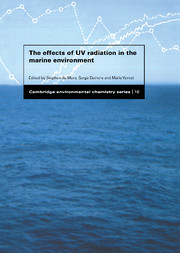Book contents
- Frontmatter
- Contents
- Contributors
- Preface
- 1 Enhanced UV radiation – a new problem for the marine environment
- 2 UV physics and optics
- 3 Spectral weighting functions for quantifying effects of UV radiation in marine ecosystems
- 4 Marine photochemistry and its impact on carbon cycling
- 5 Photochemical production of biological substrates
- 6 Mechanisms of UV damage to aquatic organisms
- 7 Strategies for the minimisation of UV-induced damage
- 8 UV radiation effects on heterotrophic bacterioplankton and viruses in marine ecosystems
- 9 Effects of UV radiation on the physiology and ecology of marine phytoplankton
- 10 Impact of solar UV radiation on zooplankton and fish
- 11 Implications of UV radiation for the food web structure and consequences on the carbon flow
- Index
8 - UV radiation effects on heterotrophic bacterioplankton and viruses in marine ecosystems
Published online by Cambridge University Press: 20 August 2009
- Frontmatter
- Contents
- Contributors
- Preface
- 1 Enhanced UV radiation – a new problem for the marine environment
- 2 UV physics and optics
- 3 Spectral weighting functions for quantifying effects of UV radiation in marine ecosystems
- 4 Marine photochemistry and its impact on carbon cycling
- 5 Photochemical production of biological substrates
- 6 Mechanisms of UV damage to aquatic organisms
- 7 Strategies for the minimisation of UV-induced damage
- 8 UV radiation effects on heterotrophic bacterioplankton and viruses in marine ecosystems
- 9 Effects of UV radiation on the physiology and ecology of marine phytoplankton
- 10 Impact of solar UV radiation on zooplankton and fish
- 11 Implications of UV radiation for the food web structure and consequences on the carbon flow
- Index
Summary
Introduction
Most research examining the effects of UV radiation (UVR) on marine microbial communities has been directed at phytoplankton and primary production. It is now apparent, however, that other microbial trophic levels must also be considered when one is investigating the ecological impact of UVR. The importance of bacterioplankton in oceanic processes has become widely recognised. Bacteria have been found to account for up to 90% of the cellular DNA in oceanic environments (Paul & Carlson, 1984; Paul, Jeffrey & Deflaun, 1985; Coffin et al., 1990) and the role of bacteria in elemental and nutrient cycling has received extensive study (Falkowski & Woodham, 1992). Bacteria have been found to play a vital role in carbon cycling, providing significant amounts of material to higher trophic levels. Various studies have shown that bacteria consume a significant proportion of primary production, although the data are quite variable and depend on location and season (Fuhrman & Azam, 1980; Hansen et al., 1983; Cota et al., 1990; Sullivan et al., 1990).
Viruses are ubiquitous and abundant in marine environments infecting bacteria, phytoplankton and heterotrophic flagellates (for reviews, see Børsheim, 1993; Fuhrman & Suttle, 1993; Bratbak, Thingstad & Heldal, 1994). While viruses are often considered to be pathogens of mammals or higher plants, it has become apparent that the 108 to 1011 viruses 1−1 that are found in marine surface waters, mostly infect marine bacteria and phytoplankton (Suttle, Chan & Cottrell, 1990; Fuhrman & Suttle, 1993).
- Type
- Chapter
- Information
- The Effects of UV Radiation in the Marine Environment , pp. 206 - 236Publisher: Cambridge University PressPrint publication year: 2000
- 32
- Cited by



